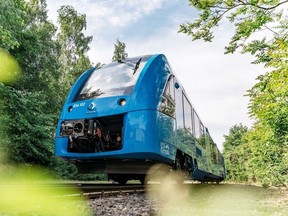Douglas Todd: A carbon-free, 99-kilometre light rail network that would connect many cities and communities untouched by the SkyTrain extension, is enthusiastically supported by public polling

In the fall, the B.C. government began construction, without ceremony, of the $6 billion SkyTrain extension from north Surrey to Langley City.
After numerous delays, signs of activity are appearing on the 16-kilometre rapid-transit line, which is $2 billion over budget and has had its completion date extended by a year to 2029.
But it’s worth noting that, throughout all the years of planning for the Langley SkyTrain extension, a much less costly, much more far-reaching and superbly ecological alternative has been recommended to the B.C. government.
Will its time ever come?
The South Fraser Community Rail Society, a group of highly informed volunteers, has been working for years to get B.C.’s Ministry of Transportation to take seriously its proposal to reactivate a light rail line that once operated south of the Fraser River.
The interurban system would directly connect north Surrey with about a dozen Fraser Valley cities and towns — a region of 1.3 million people, much more than the relatively truncated SkyTrain extension to just the city of Langley.
It would also be vastly cheaper than SkyTrain.
And that’s in large part because the passenger trains would travel along existing rail lines. In addition, advocates say, the train cars can easily be fuelled by clean-burning hydrogen.
Emitting no carbon emissions, the train would travel from north Surrey as far as Chilliwack, which compared to the 16-kilometre Skytrain extension to the City of Langley, is an extra 50 kilometres to the east.

Even though the South Fraser Community Rail Society says it once obtained a general endorsement from late NDP premier John Horgan, society member Lee Lockwood said Premier David Eby has not shown interest.
The B.C. Ministry of Highways said last week that in 2021 it conducted a feasibility study of passenger rail possibilities in the Fraser Valley and concluded “further analyses would be required.” Which is about as noncommittal as it gets.
Yet advocates say the train system would help connect many cities and communities untouched by the SkyTrain extension (including Surrey’s Newton and Cloverdale, Fort Langley, Gloucester industrial park and Sumas), eight First Nations communities, 14 post-secondary institutions and Abbotsford International Airport.
Rick Green, former mayor of Langley Township, which encircles smaller Langley City, has long been behind the cause, in part because the Trans-Canada Highway, now being widened, is increasingly jammed with cars and trucks.
One of the beauties of the proposed passenger rail system, says Green, is it would run on existing tracks, which until the 1950s had been used for a passenger service called “the B.C. Electric interurban line.”
Even though the tracks are being used by CP Rail to run freight, Green, president of the South Fraser Community Rail Society, said the province retains the right to operate passenger rail cars on them.
“It is a shame,” Condon said, “to ignore this crucial potential armature for a more sustainable Lower Mainland in favour of our hugely expensive and low-capacity SkyTrain system.”
The South Fraser Community Rail Society’s website says that while the SkyTrain extension to Langley City is costing more than $325 million a kilometre to build, the light-rail alternative would come in at just $16 million a kilometre.

In his classes at UBC’s school of architecture, Condon often cites the proposed South Fraser rail network as a prime example of an effective, decentralized transit system.
It not only avoids squeezing high-density development mostly along subway lines, he said, it can feature hydrogen-run rail cars like those produced by Alstom, which are widely used in Eastern Canada. And hydrogen fuel, he said, is readily available in B.C.
The latter stands out as a strange criticism, given the limitations of the Langley City SkyTrain extension.
“There’s an elitist mentality in some quarters,” West said, when people who live in the core of Metro Vancouver, which has viable transit options, tell people in outlying regions they should get out of their cars and move around by buses, which he says are infrequent at best.
Despite the enthusiasm of many informed people for the light rail system, B.C.’s Ministry Of Transportation and Transit, which since November has been led by Port Coquitlam MLA Mike Farnworth, will only say it’s continuing “long-range planning” to better serve the needs of the people south of the Fraser.
Without answering why the 99-kilometre network has been ignored for so long, the ministry said in a vague statement, it is “currently working with all levels of government to identify and align strategic priorities.”